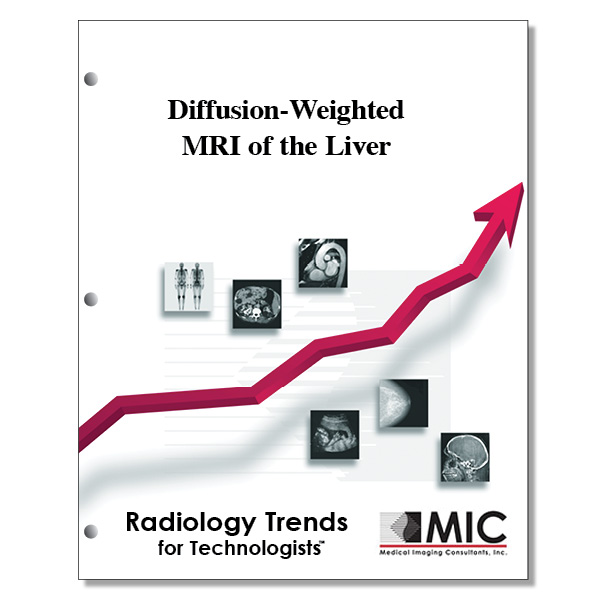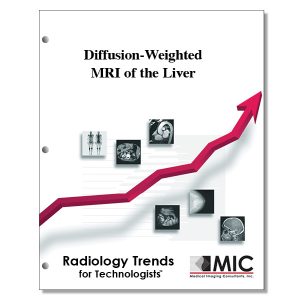

Diffusion-Weighted MRI of the Liver
A look at how advances in MRI system hardware and coil technology allow diffusion-weighted sequences to aid in liver lesion detection and characterization as well as act as a therapeutic indicator.
Course ID: Q00292 Category: Radiology Trends for Technologists Modalities: MRI, Radiation Therapy3.25 |
Satisfaction Guarantee |
$34.00
- Targeted CE
- Outline
- Objectives
Targeted CE per ARRT’s Discipline, Category, and Subcategory classification for enrollments starting after February 8, 2023:
[Note: Discipline-specific Targeted CE credits may be less than the total Category A credits approved for this course.]
Magnetic Resonance Imaging: 3.25
Image Production: 2.25
Sequence Parameters and Options: 0.50
Data Acquisition, Processing, and Storage: 1.75
Procedures: 1.00
Body: 1.00
Registered Radiologist Assistant: 1.00
Procedures: 1.00
Abdominal Section: 1.00
Outline
- Introduction
- Principles of Diffusion-weighted Imaging of the Liver
- Liver Diffusion Imaging Acquisition, Optimization, and Display
- DW MR Imaging Acquisition Techniques
- Choice of b Values and Sequence Optimization
- Image Display and Processing
- ADC Reproducibility
- Current Applications of Liver DW MR Imaging: Liver Lesion Detection
- Current Applications of Liver DW MR Imaging: Liver Lesion Characterization
- DW MR Imaging in Assessment of Tumor Response to Treatment
- Diagnosis of Liver Fibrosis and Cirrhosis with DW MR Imaging
- Estimation of Tumor Perfusion with IVIM DW MR Imaging
- Limitations of DW MR Imaging Technique in the Liver
- Future Directions
- Conclusions
Objectives
Upon completion of this course, students will:
- understand how to incorporate DW MR imaging into existing protocols
- identify why MR is useful in evaluating patients with liver disease
- understand the foundations of the principles of DW MR imaging
- understand the process of diffusion
- understand how DW MR image contrast is calculated
- identify the difference between restricted and relatively free apparent diffusion
- understand how diffusion is observed and measured
- understand the different diffusion directions measured
- understand the role of the b value in DW MR imaging of the liver
- identify the number of b values needed to quantify ADC values
- understand the information obtained from ROI quantification
- be familiar with the IVIM phenomenon
- understand advantages of specific DW MR imaging techniques
- understand the challenges of specific DW MR imaging techniques
- understand trade-offs of sequence optimization
- be familiar with the useful range of b values used in DW MR liver imaging
- understand the importance of utilizing low b values
- understand the importance of utilizing high b values
- identify trace images
- understand the importance of qualitative visual assessment in detecting liver lesions
- understand T2 shine-through
- identify lesions based on visual assessment of b value images and ADC maps
- understand quantitative assessment of ADC maps
- be familiar with the unit of measurement expressing the ADC of tissue
- understand reasons for variation in the ADC measurements
- understand why lesion detection is improved with DW MR imaging vs T2W imaging
- understand the benefit of DW MR imaging in patients with impaired renal function
- understand visual comparisons in liver lesion characterization
- be familiar with the accuracy of visual assessment in liver lesion characterization
- understand the role of published ADC values in identifying liver lesions
- be familiar with the therapies that DW MR imaging can measure tumor response to treament
- identify an effective treatment response
- identify the potential predictive value of the DW MR imaging technique
- understand how cirrhosis is diagnosed with DW MR imaing
- understand the changes in diffusion in patients with liver fibrosis
- understand which b value contributes perfusion information
- understand limitations of DW MR imaging techniques in the liver
- understand the key solution to improve image quality
- be familiar with the potential benefits of DW MR imaging at high field
- understand how to avoid limitations of the DW MR technique
